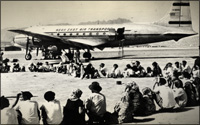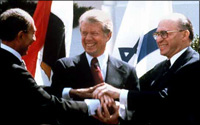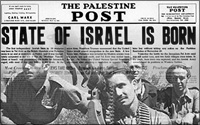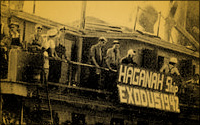 At the conclusion of the War of Independence in 1948 there were about 600,000 Jews who lived in the new country of Israel. They really thought that now they would have a chance to develop the country peacefully. They had sincerely hoped that the armistice agreements would grow into peace agreements.
At the conclusion of the War of Independence in 1948 there were about 600,000 Jews who lived in the new country of Israel. They really thought that now they would have a chance to develop the country peacefully. They had sincerely hoped that the armistice agreements would grow into peace agreements.
They were wrong. It was naïve and wishful thinking.
Early Living Conditions
There were about 250,000 European Jews waiting to come to the Land of Israel. Many of them were on Cyprus, where the British deposited them in internment camps after intercepting them trying to enter Palestine illegally. Others were still in Europe.
From 1948 to 1950 the State of Israel absorbed over 260,000 Jewish immigrants, the vast majority of whom were from European countries. From 1950 to 1954 the state would absorb almost 800,000 more Jews – almost all of them would be from Arab lands. They would be driven out of places where they had lived for over a thousand years. They would be the first tangible Jewish victims of defeating the Arabs.
The Israelis constructed mabarot — “transition camps” – but the transition was not always quick or effective. The mabarot were little more than tent cities. Sometimes they had Quonset huts with tin roofs, which in the Middle Eastern summer can broil a person and in the winter provide no protection from drafts and cold. Sanitation was at a minimum. In short, the housing situation in early Israel was disastrous.
Food, too, was a major problem. It was rationed well into the 1950s. An egg was a luxury. Bread and milk were the mainstays of the country’s diet.
On the Wings of Eagles
The first wave of Jewish immigrants from Arab lands came from Yemen. They arrived immediately upon the founding of the state in a famous operation called Magic Carpet. The name was loosely based on the biblical verse of God promising to return Jewish exiles to their homeland “on the wings of eagles.”
The Yemenite Jews had lived as a proud and scholarly but isolated Jewish community for thousands of years. Some scholars identify their traditions extending back to the First Temple era, i.e. they were in Yemen already from the time of King Solomon.
Now they had to flee for their lives and leave everything behind.
They were a religious community and saw things in a religious framework. They had been transplanted from the 14th century to the 20th century in a matter of hours. Airplanes, radios, electricity, plumbing, etc. – they were literally awestruck! It could only be because the Messiah had appeared.
Similar reactions came from later immigrants arriving from places like Morocco, Algeria, Egypt, Libya and Iraq. The vast majority of Jews saw their life within the framework of religion – even if they were not 100% observant. They did not have the Western veneer to them. However, upon arrival they were secularized overnight. It was a social upheaval of immense proportions, setting off a social time bomb which is still ticking.
A generation gap opened. Their children, as all immigrant children, wanted to assimilate and become Israeli. They did not want to be Moroccans, Iraqis or whatever their ancestry had been. Since the old generation represented religion, the new generation wanted to be extremely secular. Of course, in ensuing generations the flaws of secularism were exposed, creating a return-to-Judaism movement. This explains some of the cross currents that exist in Israeli society today.
Nevertheless, the secular nature of the state was clearly established and infused into that first generation of Israelis.
The Parliamentary System
Ben Gurion had to set up a government and a parliamentary democracy based on proportional representation was chosen. This meant that every party ran a list of candidates. People voted for a party, not a candidate. If the party won 10% of the vote they got 10% of the seats. In the Israeli Parliament, the Knesset, there are 120 seats, meaning that 10% translated into 12 seats. Consequently, the first 12 names on the party’s list of candidates would sit in the Knesset.
Such a system encourages small parties. Even if a party wins one seat it is suddenly represented in the Knesset. At the same time it minimizes the chances of any single large party winning an absolute majority of 61, which is necessary to form a government. This results in coalition governments, i.e. groups of parties compromising with each other to form a ruling majority.
It is a cumbersome system of government. If one party of the coalition does not like the way things are going they can pull out and topple the government, forcing new elections. Coalitions often dissolve over relatively small matters. Such a system opened the ruling party to special influences.
Ben Gurion wrote that in the first election there were 506,867 eligible voters and 22 parties. His party, Mapai, won 46 seats. The Mapam, which split off from Ben Gurion and was more left wing, won 19 seats. Potentially, these two left-wing socialist parties controlled enough seats to form a government, but they disagreed on Israeli foreign policy and could not come to an agreement.
Ben Gurion was forced, therefore, to make a coalition with the religious parties and other minor parties. The first coalition government, therefore, was forerunner of all Israeli coalition governments: a mixture of left wing secular and religious parties, with a great deal of negotiations on relatively minor issues.
Building an Army
Ben Gurion realized that the state needed a very strong army to survive. As early as 1950, he came to the realization that the Arabs were not going to make peace. Indeed, they would renew the conflict if they felt they could win.
He also became aware, early on, that Russia was beginning to change sides. They would no longer supply Israel with arms, as they had. The United States, meanwhile, had an arms embargo against the Jewish state; they would not sell arms to Israel until after the Six Day War. Therefore, Israel’s only option was to buy weapons on the open market. The Israelis bought weapons from wherever they could, but it was impossible to have a good army with weapons from numerous different countries. It is very hard to standardize the ammunition and training.
Therefore, Ben Gurion began to make deals. England, which was anti-Israel during the War of Independence, and which armed the Arabs, was not above selling arms to Israel through brokers in the 1950s. A great deal of English weapons, therefore, came into the Israeli army.
At the same time, Ben Gurion pushed for a universal draft and the drafting of women. The latter provoked the first major religious crisis in the country. It is a crisis that has never been resolved. Ben Gurion was a master at provoking crises. He would do it again later when he sent out a questionnaire to all the rabbis to give him the definition of a Jew, knowing full well that the age-old traditional definition.
The drafting of women was opposed by the religious parties in Israel and the Arabs. Even though the Arabs were not drafted into the army they felt it was an affront to Islam. Many of the great rabbis in the United States and Israel viewed the drafting of women as a matter of the ultimate desecration that would bring down not just the government but the state! It would open it up to a civil war.
To a certain extent – not to a great extent – Ben Gurion compromised. Exemptions from service for religious women were established, and still exist today.
Building an Economy
Israel’s main problems initially were economic. They embarked upon a program of seeking American support: public, governmental and private. The United Jewish Appeal now redoubled its efforts. It took in a very large amount of money, and funneled it for social projects in the State of Israel. Likewise, the Jewish National Fund raised capital, in this case to run the highway system and national parks, and plant trees.
As early as 1949 Israel received $150 million in aid and loans from the United States. This was a great deal of money in its time. American support since then has been the difference between economic survival and failure. Of course, it is a two-edged sword. It gives America a profound influence on Israeli life and politics – and not always for the benefit of Israel.
In addition to the American government, the second major source of funds was Israel Bonds. Through the purchase of these bonds people would lend money to the State of Israel at an interest rate somewhat below the market rate (or at least below what Israel could borrow in the world market), and use those funds for industrial and national development; not for the everyday budget but for “capital expenditures.”
The first major project of Israel Bonds was the water carrier system. This is basically a water pumping system that takes water out of the Sea of Galilee, pumps it to a high point, and from there the water runs by gravity in open aqueducts all the way down. The water is used for farming and agriculture. Through this national water carrier system, combined with improvements in technology, Israel became leaders in irrigation technology worldwide.
When the State of Israel was declared the desert in the south began about 15 miles north of Beer Sheba. Today it is about 45 miles south of Beer Sheba. They pushed the desert back almost 60 miles!
They now grow there things like cotton, tomatoes, etc. Cities like Netivot and Arad sprung up as a result. A modern city needs a tremendous amount of water. That water is part of Israel’s national carrier system. It is an amazing and enormously successful project, and one of the first investments of Israel Bonds.
The success of the Israel Bond drive had another component to it, which may have been unintended. But for a certain type of Jew it renewed identification with his Jewishness and Israel. It gave them a feeling that they were cooperating in what was then – and now – a great historic venture.
These early turbulent years were fraught with terrible problems. And many of the problems have not disappeared. However, most have been ameliorated. The problems are different. There is poverty in Israel, but it is a different level. There are housing issues in Israel, but basically there is adequate shelter in the country. There is industry. There is the infrastructure of a modern economy.
Those are the achievements when the foundation was laid at this time; when this great ingathering of exiles occurred in the first few years of the state.











